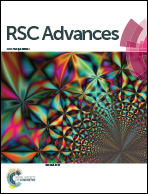Interfacial phenomena in hematite photoanodes fabricated by directly associating iron oxide suspensions with FTO substrates using a dipping-annealing method
Abstract
The fabrication of solid semiconductor nanoparticles on conductive substrates while retaining their high photocatalytic activity as they were in the dispersed form remains a challenge. In this study, we adopted the idea of used a dipping–annealing (DA) method to associate solid iron oxide nanoparticles directly onto an FTO substrate. We focused on the interfacial phenomenon of the as-fabricated hematite photoanodes to evaluate factors that may affect their photocatalytic performance. A significant sintering effect occurs during calcination; this process converts the iron (hydro)oxide precursor into a hematite structure and removes binder molecules. This sintering effect is more severe for the nanocubes than the nanospheres. However, the sintering effect would induce a size effect, further compromising the photocatalytic performance of the prepared photoanodes. Based on EIS analyses, the deteriorated photocatalytic performance arises from the deactivation that occurs at the exposed facet, increasing the open circuit potential and the resistance of hematite bulk, as well as decreasing the capacitance at the hematite–electrolyte interface.


 Please wait while we load your content...
Please wait while we load your content...